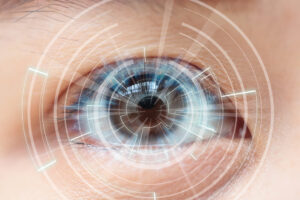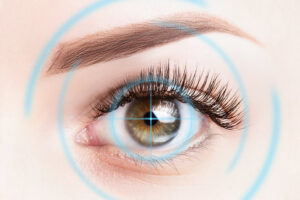
Astigmatism is a disorder of the eyes where the focus or focal plane changes while still attached to the surface of a lens or cornea. A person who is suffering from astigmatism will experience blurring, problems with perception and difficulty experience with image distortion. For those who have astigmatism, other conditions like farsightedness and shortsightedness also go hand in hand.
Many people believe that astigmatism is only can be corrected by medical intervention when it can easily be alleviated and even corrected through eye training exercises. In fact, there have been cases where with the right exercises in the right frequency yielded considerable results in just one day!
For men and women with severe cases, the improvement was seen in just a week’s time. Whether you are shortsighted or farsighted, just like working out muscles, often our eyes are in need of some cross training to strengthen certain eye muscles that have become weak over time or due to a disorder.
Eye exercises, such as Bates exercises, have been promoted by some as a way to correct astigmatism by focusing eye movements and blinking to cause contraction and relaxation of the eye muscles, relieving tension on the eye and averting exaggeration of the optical curvature. However, there is a lack of clear scientific evidence supporting the efficacy of these exercises. Several studies, as highlighted in the article, have found no clear benefit of eye exercises in treating eye issues such as myopia and low near vision. For example, a study published in the Journal of Pediatric Ophthalmology and Strabismus found no clear, scientific evidence that eye exercises could be helpful in treating myopia. Another study in the International Journal of Therapies and Rehabilitation Research found no differences in low near vision between a group that did exercises and a group that did not. Additionally, the American Academy of Ophthalmology and Harvard Health Publishing do not support the use of eye exercises as a treatment for astigmatism or other vision problems, pointing to the lack of rigorous trials and clear benefits.
Working with a doctor or medical professional is essential when dealing with vision problems like astigmatism. Medical professionals can provide evidence-based treatments such as glasses, contact lenses, or LASIK surgery that have been proven to help individuals with astigmatism see clearly. Relying on unproven methods like eye exercises can delay necessary treatment and potentially worsen vision problems. Moreover, the cause of astigmatism is not completely understood, and it is likely influenced by multiple factors including heredity. This makes it particularly important to consult a medical professional who can provide a comprehensive assessment and recommend the most appropriate treatment options. Ultimately, while eye exercises may seem like an attractive and easy solution, it is crucial to rely on proven methods and the expertise of medical professionals to effectively manage astigmatism and other vision-related issues.
Here are our top 5 eye exercises for astigmatism:
-
Rectus muscle relaxation
The rectus eye muscle can come into considerable strain over time, and astigmatism might be the result of a weak or tight rectus muscle. The rectus muscle relaxation exercise is done by gradually and gently relaxing the eye rectus muscles. The exercise should be done in the following steps:
- Put your thumb in front of your face just above the nose (about 10cm)
- Move your thumb as if it is running on a clock. First slowly move your thumb to 12 o’clock where it will disappear and leave it there for 2-3 seconds.
- If you experience tension here, that’s okay. Return to the initial nose spot and move back to 1 o’clock then again to 3,5,6,7,9, 11 and back to noon.
- From the center out, don’t forget to breathe. Exhaling slowly will help relax your muscles.
Duration: 2 minutes
Repetitions: 2-4 times per day
-
Eye Massage
Eye massages are an effective and relaxing way to reduce strain for those suffering from astigmatism. This exercise is effective because it helps restore the shape of the lens as astigmatism is when the lens has been distorted.
- Close your eyelids and place two fingers on each lid
- With gentle pressure move your fingers from right to left, top to bottom in a circular motion
- Move clockwise and counterclockwise 10-15 times repeating both the right to left and circular motions
Duration: 1 minute
Repetitions: 2-4 times per day
-
Reading
Now we don’t mean pull out just any book and start reading chapter after chapter, this is to be done a certain way to improve the pressure and strain caused by astigmatism.
- Use corrective lenses and pull out a book
- Place a playing card or another object to the side and focus on that after you’ve read one paragraph
- Switch back and forth from the book to the object
- Continue off and on until your eyes start to feel tired
Duration: 10 minutes
Repetitions: 2-4 times per day
-
See a chiropractor
People who have astigmatism tend to tilt or position their neck and head in one position more than another. Because of eye strain, most people have an incorrect stature or tilted head. It is suggested to get an adjustment to relax the neck and spine while also correcting posture.
-
Paper and peripheral vision
- Take a piece of paper that is long and wide enough to cover both of your eyes.
- Make sure the side is exposed so you are able to peek out, strengthening your peripheral vision.
- Grab your corrective lenses and attach the paper to your face at the bridge of your nose.
- Move your hand to the peripheral side of the paper one after another.
- Without moving the head, look to see the finger on either side
- Repeat
Duration: 5 minutes
Repetitions: 2-4 times per day
Each exercise is meant to improve the strain put on the eyes by astigmatism. Daily practice will absolutely help the damage that has been caused by astigmatism while giving your eyes new pathways of practice to improve your traction and span and reduce pressure. Consult with your eye doctor and ask if these exercises will help your case.
For more articles on vision check out our blogs or call and make an appointment with Diamond Vision today or contact our Atlanta Eyesight Clinic.
Contact Us
If you have more questions about LASIK procedures, get in touch with us.
Related Blogs

Timing is Everything: When to Consider LASIK After Nursing for Optimal Results
Timing is everything when considering LASIK eye surgery after nursing, and understanding the optimal period for this procedure is vital for both mother and baby.

Cataract Surgery: Restoring Clarity and Confidence
Cataract surgery is a transformative procedure that offers a new lease on clear vision and renewed confidence. As cataracts cloud the eye’s lens, causing blurred

Intralase LASIK Explained: What to Expect Before, During, and After the Procedure
Intralase LASIK is a cutting-edge procedure that offers a safe, effective, and precise way to enhance vision compared to traditional LASIK methods. Understanding what to
